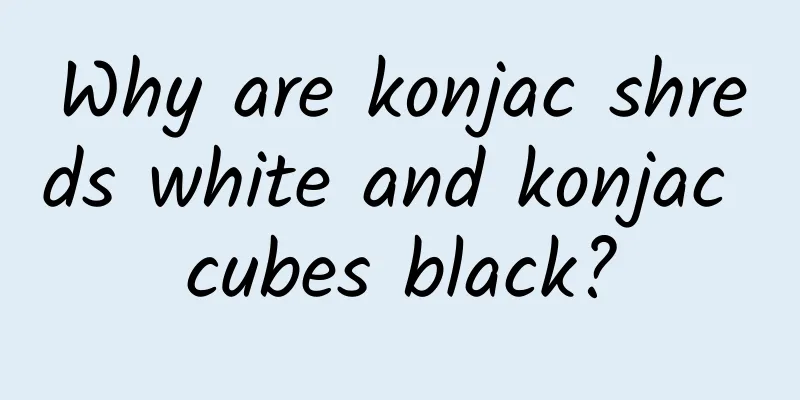Why are konjac shreds white and konjac cubes black?

|
In summer, all the fat people know one thing: "If you eat too much, you will have to pay for it." But if you eat this kind of food, you may not need to return it, that is - konjac. Konjac is low in calories and filling, and there are many konjac products available on the market, including konjac silk, konjac bread, konjac tofu, konjac meal replacement powder... A screenshot of a certain treasure Girls who are trying to lose weight, have you noticed that different forms of konjac have different colors? Common konjac shreds are white, while konjac cubes are black. Why is this? 01 Why can konjac help lose weight? Konjac, also known as konjac, is a perennial herb whose edible part is the underground stem, which is roughly oblate in shape. Konjac Konjac is rich in dietary fiber, protein, amino acids, minerals, alkaloids and other nutrients. It is one of the top ten health foods identified by the World Health Organization. However, the whole konjac plant is poisonous and cannot be eaten raw. It can only be eaten after processing. The main component of konjac after processing is glucomannan (KGM). The refined powder obtained by processing generally contains more than 65% glucomannan. Through the enhancement technology, the glucomannan content in the refined powder can reach about 80%. As a natural high-molecular water-soluble dietary fiber, glucomannan itself has very low calories and has many benefits for weight loss. Glucomannan has good water absorption and swelling properties. Only 2-3 grams of konjac flour can swell into about 200 grams of translucent viscous liquid after contact with water. Therefore, eating konjac products rich in glucomannan can easily make people feel full, delay the time of gastric emptying, and thus reduce food intake. Like other dietary fibers, glucomannan can promote gastrointestinal motility, and can also "incidentally" absorb some toxic and harmful substances and excess cholesterol, fat, etc., and excrete them from the body with feces, which helps to moisturize the intestines and promote bowel movements. Glucomannan can be fermented and degraded into short-chain fatty acids (SCFA) by microorganisms in the large intestine. Short-chain fatty acids can act on the hypothalamus by stimulating the intestinal mucosal L cells to secrete hormones, ultimately reducing hunger and suppressing appetite. 02 Why do konjac noodles and konjac cubes have different colors? There are many kinds of konjac foods on sale, the most common ones are konjac silk, konjac cubes, konjac meal replacement powder, etc. Careful friends may find that various konjac products have different shapes and colors. For example, konjac cubes are generally black, while konjac silk is white. Konjac Chips In fact, this is mainly due to the difference in raw materials and processing methods. Since the whole plant of konjac is poisonous, it must be processed before it can be eaten. Generally, the tubers of konjac are ground, washed with water to remove the juice, then lime is added, boiled and coagulated, and finally made into a gel-like edible form. The black konjac blocks are made directly from raw konjac through rough processing. Since the raw konjac will contain impurities such as skin, the finished product is darker in color, dark brown. If the harvested konjac is washed, chopped and dried into rough flour, and then ground into clean fine powder, konjac flour is obtained. Konjac flour is generally off-white, almost free of impurities, and the particles are very uniform. Konjac silk made from konjac flour is white. However, some black konjac foods nowadays are actually made from refined flour. This is because manufacturers add an appropriate amount of powder of seaweed such as arashii and hijiki to adjust the color, making it look like it is made from raw konjac. Generally, you can identify the source of the color of konjac food based on the ingredient list. For example, the dark brown konjac block shown in Figure A below is made directly from konjac; the white konjac silk shown in Figure B is made from konjac powder; and the konjac block shown in Figure C is also dark brown, but it is actually made from konjac powder, and only turns dark brown after adding seaweed kelp powder. Konjac food, source: Taobao In addition, konjac products that are directly processed from raw konjac have a slightly fishy smell, while konjac foods made from finely processed konjac flour have no fishy smell, which can also be used as a judgment method. In addition to black and white konjac foods, various ingredients such as aokai, soy milk, plum, chili powder, sudachi, and perilla are often added to the production of konjac today to add richer colors to it. Image source: wikipedia 03 Tips for eating konjac products Although konjac products are very suitable foods for weight loss, the processing process will cause the loss of corresponding nutrients. For example, the starch, protein and vitamin content of konjac foods are low. If consumed for a long time, it may cause malnutrition and vitamin deficiency. Therefore, it is best to consume konjac food as a way to change your diet structure and reduce your food intake only in the early stages of weight loss. You should pay attention to the amount you consume. It should not be used as a staple food for a long time and can only be a partial substitute. Moreover, konjac is rich in water-soluble dietary fiber, which is not easily digested and absorbed by the body. For people with gastrointestinal diseases, it will increase the burden of gastrointestinal digestion and affect the absorption of vitamins and minerals. Did you eat konjac to lose weight this summer? References [1] Wei Enhui, Wu Jihong, Liu Bing, et al. Properties of konjac glucomannan and its application in food[J]. Food Industry, 2016(5):4. [2] Sun Yuanming, Wu Qing, Chen Guolian, et al. Structure, food properties and health functions of konjac glucomannan [J]. Food and Fermentation Industries, 1999, 25(5):47-51. [3] Long Deqing et al. Development and research progress of konjac[J]. Food Science and Technology, 2003 END Audit expert: Wang Guoyi, Postdoctoral Fellow in Food Safety Tadpole Musical Notation original article, please indicate the source when reprinting Editor/Heart and Paper |
<<: Beware of hidden salt! Say no to "heavy taste"!
>>: How high should the air conditioner be set?
Recommend
4 private domain community marketing formulas!
In recent years, the concept of private domain co...
National New Energy Vehicle Project Team: Four points to understand the energy consumption of electric vehicles per 100 kilometers is the key to getting points
Statistics show that China consumed 556 million t...
Toutiao’s information flow ads do not support oCPC. What is the motivation behind this?
I wrote an article about Toutiao before, which wa...
79 New Consumer Brand Marketing Tips
To achieve success in one fell swoop is to occupy...
How to avoid the pitfalls of marketing planning activities?
In the current market environment, product promot...
Dashan's "TikTok Advanced Practical Course" explains the account in detail, traffic operation, and practical realization
Training course video lecture content introductio...
How many years can a mobile phone last? Three main factors determine the lifespan of a mobile phone
[[429168]] Computers have a history of developmen...
Money is too easy to make: Apple and Google's app store "taxes" spark public outrage
Beijing time, August 23, morning news, more and m...
These 5 changes in iOS14 interaction are worth studying carefully
I have always liked the interactive design of the...
Permission issues in Android
In Android programs, permissions must be declared...
What aspects should be taken into consideration to build a good UGC platform?
UGC , or User-Generated Content, refers to conten...
Ruifeng S3 road test spy photos exposed with longer body size and upgraded power system
Recently, road test spy photos of the new Ruifeng...
NRDC & Peking University: Research on the potential for coal-fired power transformation and optimization in typical provinces in China
Based on the characteristics of geographical loca...
Sunbathing my back for 10 days made me lose 4 catties. Can sunbathing your back during the dog days really help you lose weight? The truth is →
"Sunbathing your back more during the dog da...
Gmail is not an iron wall
Gmail, a widely used email service under Google, h...









